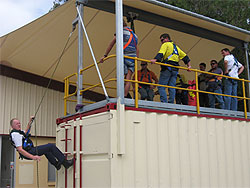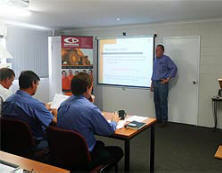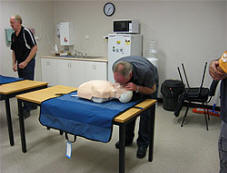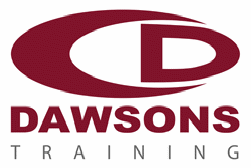





Dawsons Training Division was strategically set up to ensure that the Dawsons staff have the most up to date qualifications. Today our courses are offered to the public - both at set times and as required by our clients - delivered from our premises in Cairns and on our client's sites.
Our trainers have over 35 years experience in the mining industry throughout Australia, New Guinea and Fiji.
Our training division includes simulation facilities, delivery equipment, quality controlled tag and tested harnesses, fire extinguishers, CPR dummies, ropes, as well as laptops, projectors, and 3 rooms with a capacity of 25 clients in each.
Our location adjacent to the Cairns domestic and international airports enables us to train clients before they fly back to their mine sites.
Our relationships also extends to mining companies using our facilities for other training, such as refreshing staff in specific mine procedures/processes and policies, and non accredited training programs.
Please feel free to contact the training department on 07 4058 5212 for your training requirements
Taining Courses:
LICENCE TO OPERATE A BOOM-TYPE ELEVATING WORK PLATFORM (BOOM LENGTH 11 METRES OR MORE)
The training to achieve this High Risk Work Licence – (WP), consists of 3 components: formal theory training, supervised work experience and practical assessment. We offer three options to obtain the licence
SITE SUPERVISOR TRAINING
This course is designed for those required to undertake supervisory roles in the resources and infrastructure industry. The training consists of the following 3 nationally accredited units of competency (which are required competencies for statutory coal mining positions as determined by the Coal Mining Safety and Health Advisory Committee):
HLTAID003, HLTAID001 FIRST AID AND CPR
This first aid course aims to provide participants with the necessary skills to provide; first aid response, life support and management of casualty(s), incidents and emergency situations.
The nationally accredited training consists of both theory and practical sessions.
This requires students to have physical mobility to perform at least 2 minutes of uninterrupted, single rescuer, cardiopulmonary resuscitation (CPR), on an adult resuscitation manikin that is on the floor. Please contact our friendly staff if you are affected by these requirements.
PERFORM RESCUE FROM A LIVE LV PANEL
This training course is based on the Units of Competency UETTDRRF06: Perform rescue from a live LV panel and HLTAID001 Provide cardiopulmonary resuscitation.
This course describes the skills and knowledge required to perform rescue from a live LV panel and Cardiopulmonary Resuscitation (CPR) in line with the Electrical Safety Regulations and Australian Resuscitation Council (ARC) guidelines.
CPCCWHS1001 PREPARE TO WORK SAFELY IN THE CONSTRUCTION INDUSTRY (WHITE CARD)
This course is an introduction into safe work practices for the construction industry. It is designed to meet Workplace Health and Safety requirements for a site safety induction and must be achieved before access to any building and construction.
Once assessed as competent the participant will receive an official Workplace Health & Safety white card.
ENTER AND WORK IN CONFINED SPACES
The confined space course is aimed at entering and working in confined spaces within the resource and infrastructure industries. It includes training in planning and preparation, including hazards and risk management controls. The participants will also gain skills for safely entering, working in or exiting confined spaces.
This nationally accredited training consists of both theory and practical sessions.
WORK SAFELY AT HEIGHTS
The working at heights course offers the use of height safety equipment, including safety harnesses and fall arrest systems appropriate to the working environment. Participants will also receive training in understanding associated hazards and risk management controls, strengths and limitations of the equipment, and the relevant inspection and maintenance requirements.
This nationally accredited training consists of both theory and practical sessions.
RESPOND TO LOCAL EMERGENCIES AND INCIDENTS
This unit describes the skills and knowledge required to respond to a range of local emergencies and incidents. It includes implementing response plans, monitoring the situation, taking necessary precautionary measures, and supporting formal relief. This unit applies to those working in site-based roles in the coal mining, metalliferous mining, drilling, extractive, and civil infrastructure environments.
Licensing, legislative, regulatory and certification requirements that apply to this unit can vary between States, Territories, and industry sectors, and must be sourced from state jurisdictions prior to applying the unit.
LICENCE TO PERFORM DOGGING
The training to achieve this High Risk Work Licence – Dogging (DG), consists of 3 components: Formal theory training, supervised work experience and Licensing assessment. We offer two options to obtain the licence:
Option 1 – Dogging WORK READY (5 days)
This is a 5 day intensive training and assessment course. Participants will attend on all 5 days to complete Formal Theory, practical training and Licensing assessment with our qualified trainer and assessor.
Option 2 – Dogging LOG BOOK (3 days Formal Training + Licensing Assessment)
During the 3 day formal theory session participants will gain the required knowledge to safely and effectively perform dogging operations, after which they will be required to obtain and log hours via work experience. The participant must be supervised when performing duties by a person with an equivalent licence in dogging operations. A log book showing the completed hours will be required to be sighted by the accredited assessor prior to assessment.
Participants are welcome to book in for assessment when their Supervisor feels they are competent to undertake the Mandated Licensing Assessment.
Please note: It is up to the participant to organise their own access to perform operations as a dogman under the supervision of a licenced Dogman.
LICENCE TO OPERATE A FORKLIFT TRUCK
The training to achieve this High Risk Work Licence – Forklift (LF), consists of 3 components: Formal theory training, supervised work experience and assessment. We offer three options to obtain the licence:
Work Ready – 3 day intensive training including formal theory training, practical training and licensing assessment.
Log Book – 1 day formal theory training, after which you will be required to obtain and log hours of experience on the job training. Log book must be presented to RTO prior to booking in for licensing assessment.
Experienced – To be permitted enrolment via this option, evidence of previous LF Licence must be provided 1 day formal theory training, challenge assessment and licensing assessment.
OPERATE A GANTRY OR OVERHEAD CRANE
During this one day session, participants will gain the required knowledge and skills for the safe and effective operation of a gantry or overhead crane.
This nationally accredited training consists of both theory and practical sessions.
NON-SLEWING MOBILE CRANE (GREATER THAN 3 TONNES CAPACITY)
During the 2 day formal theory sessions participants will gain the required knowledge to safely and effectively operate a non-slewing mobile crane, after which they will be required to obtain and log 60 nominal hours via work experience.
The participant must be supervised when performing duties by a person with an equivalent licence in non-slewing mobile crane operations.
A log book showing the completed nominal hours will be required to be sighted by the accredited assessor prior to assessment.
Please note: It is up to the participant to organise their own access to operate a slewing mobile crane under the supervision of a licenced operator and obtain the required nominal hours.
GAS TEST ATMOSPHERES
This unit is about testing the working atmosphere to determine if it is safe for the proposed. Testing involves the use of electronic test apparatus. The competency requires the person to interpret readings and take actions based on the interpretation.
This nationally accredited training consists of both theory and practical sessions.